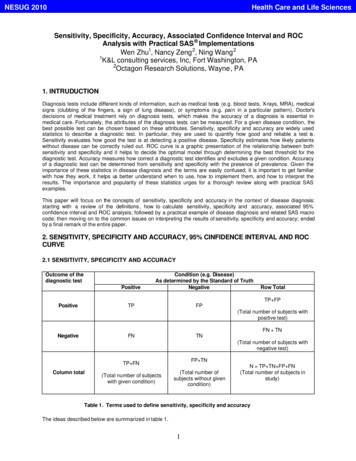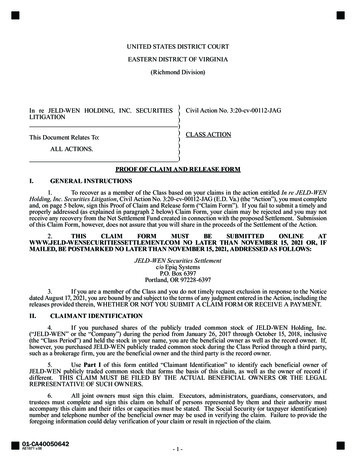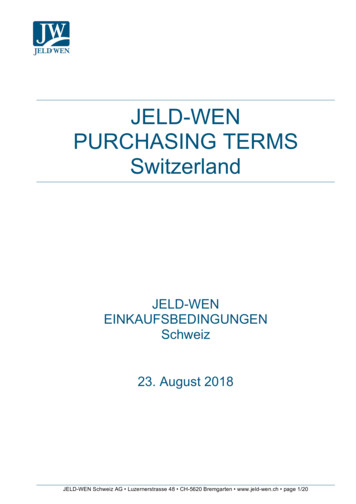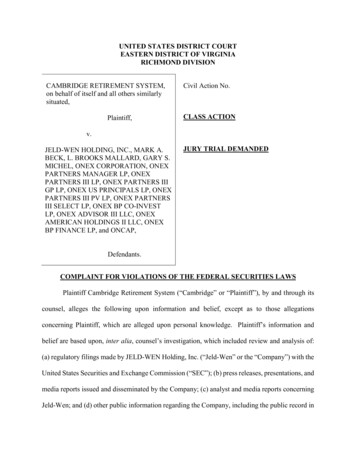
Transcription
NESUG 2010Health Care and Life SciencesSensitivity, Specificity, Accuracy, Associated Confidence Interval and ROCAnalysis with Practical SAS ImplementationsWen Zhu1, Nancy Zeng 2, Ning Wang 21K&L consulting services, Inc, Fort Washington, PA2Octagon Research Solutions, Wayne, PA1. INTRUDUCTIONDiagnosis tests include different kinds of information, such as medical tests (e.g. blood tests, X-rays, MRA), medicalsigns (clubbing of the fingers, a sign of lung disease), or symptoms (e.g. pain in a particular pattern). Doctor’sdecisions of medical treatment rely on diagnosis tests, which makes the accuracy of a diagnosis is essential inmedical care. Fortunately, the attributes of the diagnosis tests can be measured. For a given disease condition, thebest possible test can be chosen based on these attributes. Sensitivity, specificity and accuracy are widely usedstatistics to describe a diagnostic test. In particular, they are used to quantify how good and reliable a test is.Sensitivity evaluates how good the test is at detecting a positive disease. Specificity estimates how likely patientswithout disease can be correctly ruled out. ROC curve is a graphic presentation of the relationship between bothsensitivity and specificity and it helps to decide the optimal model through determining the best threshold for thediagnostic test. Accuracy measures how correct a diagnostic test identifies and excludes a given condition. Accuracyof a diagnostic test can be determined from sensitivity and specificity with the presence of prevalence. Given theimportance of these statistics in disease diagnosis and the terms are easily confused, it is important to get familiarwith how they work, it helps us better understand when to use, how to implement them, and how to interpret theresults. The importance and popularity of these statistics urges for a thorough review along with practical SASexamples.This paper will focus on the concepts of sensitivity, specificity and accuracy in the context of disease diagnosis:starting with a review of the definitions , how to calculate sensitivity, specificity and accuracy, associated 95%confidence interval and ROC analysis; followed by a practical example of disease diagnosis and related SAS macrocode; then moving on to the common issues on interpreting the results of sensitivity, specificity and accuracy; endedby a final remark of the entire paper.2. SENSITIVITY, SPECIFICITY AND ACCURACY, 95% CINFIDENCE INTERVAL AND ROCCURVE2.1 SENSITIVITY, SPECIFICITY AND ACCURACYOutcome of thediagnostic testPositiveCondition (e.g. Disease)As determined by the Standard of TruthNegativeRow TotalTP FPPositiveTPFP(Total number of subjects withpositive test)FN TNNegativeFNTN(Total number of subjects withnegative test)FP TNTP FNColumn total(Total number of subjectswith given condition)(Total number ofsubjects without givencondition)N TP TN FP FN(Total number of subjects instudy)Table 1. Terms used to define sensitivity, specificity and accuracyThe ideas described below are summarized in table 1.1
NESUG 2010Health Care and Life SciencesThere are several terms that are commonly used along with the description of sensitivity, specificity and accuracy.They are true positive (TP), true negative (TN), false negative (FN), and false positive (FP). If a disease is provenpresent in a patient, the given diagnostic test also indicates the presence of disease, the result of the diagnostic testis considered true positive. Similarly, if a disease is proven absent in a patient, the diagnostic test suggests thedisease is absent as well, the test result is true negative (TN). Both true positive and true negative suggest aconsistent result between the diagnostic test and the proven condition (also called standard of truth). However, nomedical test is perfect. If the diagnostic test indicates the presence of disease in a patient who actually has no suchdisease, the test result is false positive (FP). Similarly, if the result of the diagnosis test suggests that the disease isabsent for a patient with disease for sure, the test result is false negative (FN). Both false positive and false negativeindicate that the test results are opposite to the actual condition.Sensitivity, specificity and accuracy are described in terms of TP, TN, FN and FP.Sensitivity TP/(TP FN) (Number of true positive assessment)/(Number of all positive assessment)Specificity TN/(TN FP) (Number of true negative assessment)/(Number of all negative assessment)Accuracy (TN TP)/(TN TP FN FP) (Number of correct assessments)/Number of all assessments)As suggested by above equations, sensitivity is the proportion of true positives that are correctly identified by adiagnostic test. It shows how good the test is at detecting a disease. Specificity is the proportion of the true negativescorrectly identified by a diagnostic test. It suggests how good the test is at identifying normal (negative) condition.Accuracy is the proportion of true results, either true positive or true negative, in a population. It measures the degreeof veracity of a diagnostic test on a condition.The numerical values of sensitivity represents the probability of a diagnos tic test identifies patients who do in facthave the disease. The higher the numerical value of sensitivity, the less likely diagnos tic tes t returns false-positiveresults. For example, if sensitivity 99%, it means: when we conduct a diagnostic test on a patient with certaindisease, there is 99% of chance, this patient will be identified as positive. A test with high sensitivity tents to captureall possible positive conditions without missing anyone. Thus a test with high sensitivity is often used to screen fordisease.The numerical value of specificity represents the probability of a test diagnoses a particular disease without givingfalse-positive results. For example, if the specificity of a test is 99%. It means: when we conduct a diagnostic test ona patient without certain disease, there is 99% chance; this patient will be identified as negative.A test can be very specific without being sensitive, or it can be very sensitive without being specific. Both factors areequally important. A good test is a one has both high sensitivity and specificity. A good example of a test with highsensitive and specificity is pregnancy test. A positive result of pregnancy test almost for sure suggests the subjectwho took the test is pregnant. A negative result almost certainly rules out the possibility of being pregnant.In addition to the equation show above, accuracy can be determined from sensitivity and specificity, whereprevalence is known. Prevalence is the probability of disease in the population at a given time:Accuracy (sensitivity) (prevalence) (specificity) (1 - prevalence).The numerical value of accuracy represents the proportion of true positive results (both true positive and truenegative) in the selected population. An accuracy of 99% of times the test result is accurate, regardless positive ornegative. This stays correct for most of the cases. However, it worth mentioning, the equation of accuracy impliesthat even if both sensitivity and specificity are high, say 99%, it does not suggest that the accuracy of the test isequally high as well. In addition to sensitivity and specificity, the accuracy is also determined by how common thedisease in the selected population. A diagnosis for rare conditions in the population of interest may result in highsensitivity and specificity, but low accuracy. Accuracy needs to be interpreted cautiously.2.2 ASYMPTOTIC AND EXACT 95% CONFIDENCE INTERVALThe sensitivity, specificity and accuracy are proportions, thus the according confidence intervals can be calculated byusing standard methods for proportions 1. Two types of 95% confidence intervals are generally constructed aroundproportions: asymptotic and exact 95% confidence interval. The exact confidence interval is constructed by usingbinomial distribution to reach an exact estimate. Asymptotic confidence interval is calculated by assuming a normalapproximation of the sampling distribution. The choice of these two types of confidence interval depends on whetherthe sample proportion is a good approximation of normal distribution. If the number of event is very small or if thesample size is very small, the normal assumption cannot be met. Thus, exact confident interval is desired. SASexample for both types of 95% confidence intervals will be provided in section 3.2
NESUG 2010Health Care and Life Sciences2.3 RECEIVER OPERATING CHARACTERISTICS (ROC) ANALYSISFor a given diagnostic test, the true positive rate (TPR) against false positive rate (FPR) can be measured, whereTPR TP/(TP FN)AndFPR FP/(FP TN)As we can see from the above equations, TPR is equivalent to sensitivity and FPR is equivalent to (1 – specificity). Allpossible combinations of TPR and FPR compose a ROC space. One TPR and one FPR together determine a singlepoint in the ROC space, and the position of a point in the ROC space shows the tradeoff between sensitivity andspecificity, i.e. the increase in sensitivity is accompanied by a decrease in specificity. Thus the location of the point inthe ROC space depicts whether the diagnostic classification is good or not. In an ideal situation, a point determinedby both TPR and FPF yields a coordinates (0, 1), or we can say that this point falls on the upper left corner of theROC space. This idea point indicates the diagnostic test has a sensitivity of 100% and specificity of 100%. It is alsocalled perfect classification. Diagnostic test with 50% sensitivity and 50% specificity can be visualized on the diagonaldetermined by coordinate (0, 0) and coordinates (1, 0). Theoretically, a random guess would give a point along thisdiagonal. A point predicted by a diagnostic test fall into the area above the diagonal represents a good diagnosticclassification, otherwise a bad prediction. A graphic presentation of what described above is shown in figure 1.1Ideal coordinate (0, 1)0.8Cut-point0.6Sensitivity (TPR)Random classification0.40.200.20.40.60.811-specificity (FPR)Figure 1: ROC Space: shadow area represents better diagnosticclassificationA single cut-point of a diagnostic test defines one single point in the ROC space; however, different possible cutpoints of a diagnostic test determine a curve in ROC space, which is also called ROC curve. Like a single point in the3
NESUG 2010Health Care and Life SciencesROC space, ROC curve is often plotted by using true positive rate (TPR) against false positive rate (FPR) for differentcut-points of a diagnostic test, starting from coordinate (0, 0) and ending at coordinate (1, 1). FPR (1 – specificity) isrepresented by x-axis and TPR (sensitivity) is represented by y-axis. Thus, ROC curve is a plot of a test’s sensitivityvs. (1-specificity) as well. The interpretation of ROC curve is similar to a single point in the ROC space, the closer thepoint on the ROC curve to the ideal coordinate, the more accurate the test is. The closer the points on the ROC curveto the diagonal, the less accurate the test is. In addition, (1) the faster the curve approach the ideal point, the moreuseful the test results are; (2) the slope of the tangent line to a cut-point tells us the ratio of the probability ofidentifying true positive over true negative, i.e. likelihood ratio (LR) for the test value: LR sensitivity/(1-specificity), ifthe ratio is equal to 1, the selected cut-point doesn’t add additional information to identify true positive result. If theratio is greater than 1, the selected cut-point help identify true positive result. If the ratio is less than 1, itdecreases disease likelihood (3) the area under ROC curve (AUC) provides a way to measure the accuracy of adiagnostic test. The larger area, the more accurate the diagnostic test is. AUC of ROC curve can be measured by thefollowing equation, Where t (1 – specificity) and ROC (t) is sensitivity.Commonly used classification using AUC for a diagnostic test is summarized in table 2:Table 2: accuracy classification by AUC for a diagnostic testAUC Range0.9 AUC 1.00.8 AUC 0.90.7 AUC 0.80.6 AUC 0.7ClassificationExcellentGoodWorthlessNot goodIn short, ROC curve is a good tool to select possible optimal cut-point for a given diagnostic test.3. AN PRACTICAL EXAMPLE WITH SAS CODEA good example explains better. Suppose, if there is an existing test that can always identify the true positive and truenegative in determining the presence or absence of haemodynamically relevant stenosis of the renal arteries.However it is very time-consuming and expensive. A more efficient and affordable test is discovered, the preliminaryresults shows high sensitivity and specificity. A trial is then carried out to confirm the efficacy of this diagnostic test.Assuming the existing test has 100% accuracy, it will be used as the standard of truth, in other words, we believe thatthe test results always reflect the true stenosis of the renal arteries. A population of patients is enrolled, and bothexisting test and trial test are performed on each patient in order to obtain comparable results. And the test resultsare record in the following dataset data1. And the SAS examples used to calculate the sensitivity, specificity,accuracy and associated asymptotic and exact confidence interval are provided below:A dummy dataset is created below: data1, in which test1 is standard of truth, test2 is for trial test result. value 0 fortest1 and test2 means disease absent, while 1 means disease present.data data1;input id test1 test2;datalines;sub01 1 0sub02 1 0sub03 0 0sub04 0 1sub05 1 1sub06 1 1sub07 1 1sub08 0 0sub09 1 0sub10 1 1sub11 1 1sub12 1 1sub13 0 0sub14 0 04
NESUG ub34sub35sub36sub37sub38sub39sub40;run;Health Care and Life 0000101000Compare the test result with the standard of truth and assigne TP, TN, FP, FN to each test result following theguidance of table 1.data data2;set data1;if test1 1 thendo;if test2 1 thenelse if test2 0end;else if test1 0 thendo;if test2 1 thenelse if test2 0end;run;result c12 "TP";then result c12 "FN";result c12 "FP";then result c12 "TN";proc sort data data2;by test1 test2 ;run;Once the results are assigned to different categories, the sensitivity, specificity and accuracy can be easily calculatedby using the formula provided in previous section of this table. The following SAS code can be used for thecalculations.This data step generates count for sensitivity and specificity.data main1 (drop id result c12);set data2;by test1;retain tp tn fp fn;if (first.test1) then do;tp 0; tn 0; fp 0; fn 0;end;if (result c12 in ("TP")) then tp tp 1;if (result c12 in ("TN")) then tn tn 1;if (result c12 in ("FN")) then fn fn 1;5
NESUG 2010Health Care and Life Sciencesif (result c12 in ("FP")) then fp fp 1;else ;if (last.test1) then output;run;This data step generates accuracy count.data main2;set main1;tntp tn tp;fnfp fn fp;run;Total count of sensitivity, specificity and accuracy could be summed up by proc SQL.proc sql;create table main3 asselect sum(tp) as tp, sum(tn) as tn, sum(fp)as fp, sum(fn) as fn, sum(tntp) astntp, sum(fnfp) as fnfpfrom main2;quit;3.1 SENSITIVITY, SPECIFICITY AND ACCURACYproc sql;create table main4 asselect tp/(tp fn) as sensitivity, tn/(tn fp) as specificity,(tn tp)/(tn tp fn fp) as accuracyfrom main3;quit;This MAIN4 dataset shows the sensitivity, specificity and accuracy of the diagnosis .2 ASYMPTOTIC AND EXACT 95% CONFIDENCE INTERVALCreate a dataset for calculating 95% confidence interval; the dataset follows the format showing in table 3.2.proc transpose data main3 out t main;var tp tn fn fp tntp fnfp;run;data table32 (drop name col1);length group 20;set t main;count col1;if name "tp" then do;group "Sensitivity";response 0;output;end;else if name "fn" then do;group "Sensitivity";response 1;output;end;else if name "tn" then do;group "Specificity";response 0;output;6
NESUG 2010Health Care and Life Sciencesend;else if name "fp" then do;group "Specificity";response 1;output;end;else if name "tntp" then do;group "Accuracy";response 0;output;end;else if name "fnfp" then do;group "Accuracy";response 1;output;end;run;Table 3.2 format of the dataset for calculating 95% confidence TN TPFN FPproc freq data table32;weight count;by group;tables response/alpha 0.05 binomial(p 0.5);exact binomial;run;The 95% confidence interval outputted from the SAS procedure is listed below:RateAsymptotic 95% CISensitivity0.7(0.4992, 0.9008)Specificity0.85(0.6935, 1.0000)Accuracy0.775(0.6456, 0.9044)Exact 95% CI(0.4572, 0.8811)(0.6211, 0.9679)(0.6155, 0.8916)3.3 RECEIVER OPERATING CHARACTERISTICS (ROC) ANALYSISROC analysis also allows analyzing sensitivity and specificity simultaneously at different cut-points; this approachbetter estimates the accuracy of a given trial test by using multiple pairs of sensitivity and specificity. In the previousexample, a trial test is to measure the degree of occlusion (stenosis vs . non-stenosis ). With ROC analysis, the trialtest evaluates a continuous degree of stenosis , also called the cut-off points, these points are chosen from 20%upwards to 80% percent stenosis. Trial test at each cut-off point returns one sensitivity and one specificity. The ROCanalysis plots all sensitivity vs . (1-specificity) at selected cut-offs points by placing each pair of sensitivity and (1specificity) in ROC space. The area under the curve (AUC) is a parameter indicating the intrinsic accuracy of thediagnostic test in determining the haemodynamically relevant stenosis of renal arteries. The sensitivity and specificityfor each cut-point is calculated in the same way described in previous section and recorded in a dataset namedDATA ROC (variable SENS is for sensitivity and spec1 is for 1-Specificity). The SAS example used to generate theROC curve and AUC are provided below.The dummy data that the example based on is as follow:data data roc;input order cut sens spec spec1;datalines;1 0.80 0.11 0.95 0.052 0.70 0.30 0.90 0.107
NESUG 20103456Health Care and Life city)0.850.340.200.120.100.05proc gplot data data roc;symbol1 v square i j;plot sens*spec1/ vaxis 0 to 1 by 0.1 haxis 0 to 1 by 0.1;label sens "Sensitivity" spec1 cificityFigure 2. Sample ROC plot: x-axis (1-specificity), y-axis sensitivity. The area under the ROC curverepresents accuracy of a trial test. ROC curve AUC is determined by multiple cut-points of the trial test, itgives better estimate of accuracy.ROC curve AUC can be calculated by the following data step:data auc;set data roc end eof;drop lagx lagy;lagx lag(spec1);lagy lag(sens);if order 1 then do;lagx 0;lagy 0;end;tpzd (spec1-lagx)*(sens lagy)/2;sumtpz tpzd;8
NESUG 2010Health Care and Life Sciencesif eof then do;roc auc sumtpz (1-spec1)*(sens 1)/2;;output;end;run;The AUC obtained from the above code and data is 0.8010. According to table 2, the trial test has fairly goodaccuracy.REFERENCE1. Gardner MJ, Altman DG. Calculating confidence intervals for proportions and their differences. In: Gardner MJ,Altman DG, eds. Statistics with confidence. London: BMJ Publishing Group, 1989:28-33ACKNOWLEDGEMENT AND COPYRIGHT INFORMATIONSAS and all other SAS Institute Inc. product or service names are registered trademarks or trademarks of SASInstitute Inc. in the USA and other countries. indicates USA registration.Other brand and product names are trademarks of their respective companies.CONTACT INFORMATIONQuestions and Feedbacks are welcome, please send them to:Wen ZhuK&L Consulting Services, Inc.1300 Virginia Drive, Suite 103,Fort Washington, PA ancy ZengOctagon Research Solution, Inc.585 East Swedeford Rd. Suite 200Wayne, PA 19087610-535-6500 ext 5803nzeng@octagonresearch.comNing WangOctagon Research Solution, Inc.585 East Swedeford Rd. Suite 200Wayne, PA 19087610-535-6500 ext 5633nwang@octagonresearch.com9
1 Sensitivity, Specificity, Accuracy, Associated Confidence Interval and ROC Analysis with Practical SAS Implementations Wen Zhu1, Nancy Zeng 2, Ning Wang 2 1K&L consulting services, Inc, Fort Washington, PA 2Octagon Research Solutions, Wayne , PA 1. INTRUDUCTION Diagnosis tests include different kinds of information, such as medical tests (e.g. blood tests, X-rays, MRA), medical










